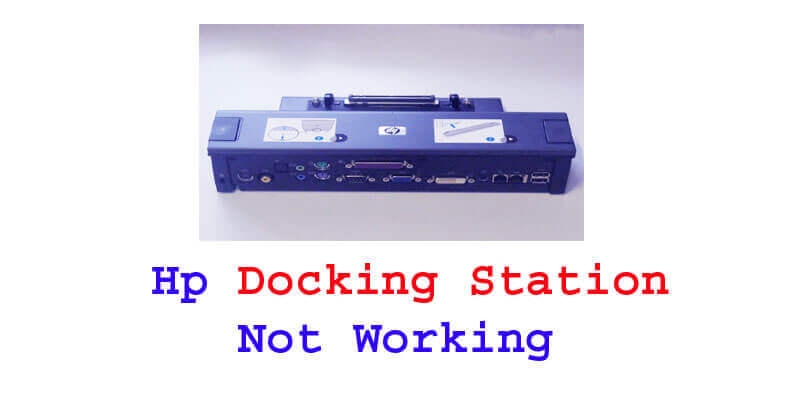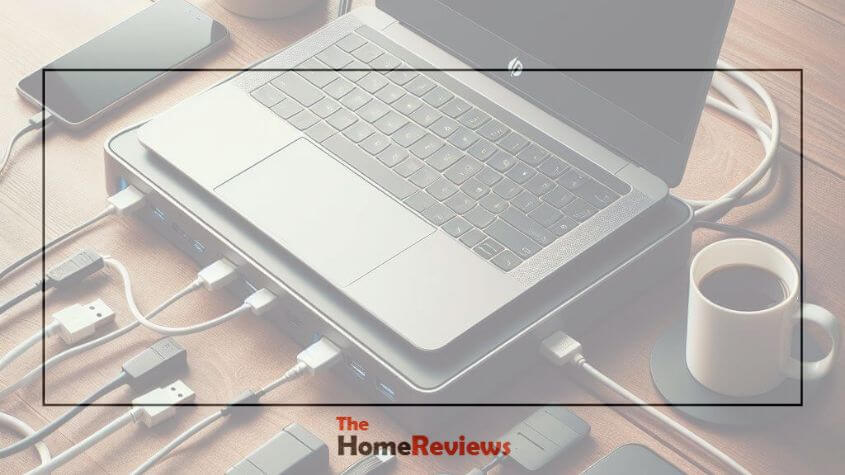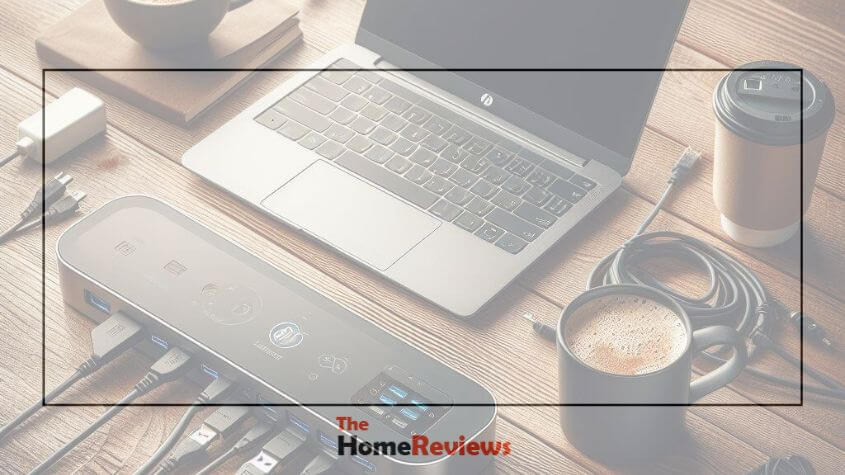If your HP docking station is not working, it could be due to compatibility issues or a faulty connection. Here is a brief troubleshooting guide to help you resolve the problem.
Technology can be frustrating sometimes, especially when your HP docking station is not functioning correctly. This issue can stem from compatibility problems or a faulty connection. In this article, we will provide you with a concise troubleshooting guide to help you fix the issue and get your docking station working again.
Whether you use it for work or leisure, a functional docking station is essential for seamless connectivity. Let’s delve into the possible causes and solutions to get your HP docking station up and running properly again.

Understanding The HP Docking Station
Overview Of The HP Docking Station’s Purpose And Function
The HP docking station is an essential accessory that enhances the connectivity and usability of your HP laptop or computer. It serves as a bridge between your device and other peripherals, providing convenience and efficiency in the workplace or at home.
Let’s explore the primary purpose and function of the HP docking station in detail.
- Simplifies connectivity: The HP docking station allows you to easily connect your laptop or computer to various devices such as monitors, keyboards, mice, printers, and more. With just one connection, you can access multiple peripherals effortlessly.
- Expands display options: One of the standout features of the HP docking station is its ability to expand your display options. It enables you to connect multiple monitors, transforming your workspace into a multitasking powerhouse. You can have different applications or documents on separate screens, enhancing productivity and minimizing the need for constant window switching.
- Provides power and charging: The HP docking station not only connects your laptop or computer to peripherals but also acts as a power hub. It allows you to charge your device while connected, eliminating the need for multiple power cables and adapters. This feature is especially beneficial for users who require extended usage periods without interruption.
- Streamlines cable management: With an HP docking station, you can reduce cable clutter and optimize your workspace. Instead of connecting and disconnecting various devices every time you need to move, simply attach or detach your laptop from the docking station. This eliminates the hassle of dealing with multiple cables and ensures a tidy and organized setup.
Key Features And Benefits Of Using An HP Docking Station
The HP docking station offers a range of features and benefits that enhance the user experience and productivity. Let’s dive into the key highlights of using an HP docking station:
- Seamless connectivity: The HP docking station provides seamless connectivity, allowing you to quickly and effortlessly connect your laptop or computer to a wide range of peripherals. This ensures easy access to all your devices in one central location.
- Enhanced productivity: By expanding your display options, the HP docking station enables multitasking and increases productivity. You can have multiple windows open simultaneously, view content on different monitors, and work more efficiently.
- Portability and flexibility: With its portable design, the HP docking station allows you to easily connect and disconnect your laptop on the go. Whether you’re working in different locations or attending meetings, you can enjoy the benefits of a full desktop setup wherever you are.
- Efficient cable management: Say goodbye to tangled cables and a cluttered workspace. The HP docking station streamlines cable management by providing a single connection point for all peripherals. This minimizes cable clutter and promotes a clean and organized environment.
Common Devices And Connections Supported By The HP Docking Station

The HP docking station supports a wide range of devices and connections, ensuring compatibility and versatility. Here are some common devices and connections you can expect with the HP docking station:
- Multiple monitors: The HP docking station allows you to connect multiple monitors, extending your display capabilities and maximizing productivity.
- USB peripherals: You can effortlessly connect USB devices such as keyboards, mice, external hard drives, and printers to the HP docking station. This simplifies access to these peripherals and eliminates the need for separate connections to your laptop.
- Audio devices: Whether it’s speakers, headphones, or microphones, the HP docking station supports various audio devices, providing convenient audio connectivity.
- Ethernet connection: The HP docking station features an Ethernet port, enabling you to establish a stable and reliable wired internet connection. This is especially useful in situations where a Wi-Fi connection may be unreliable or unavailable.
- Charging capabilities: In addition to connecting devices, the HP docking station can charge your laptop while it’s connected. This eliminates the hassle of carrying separate chargers and ensures an uninterrupted power supply.
The HP docking station offers a wealth of possibilities for expanding your device’s connectivity and optimizing your workspace. Its purposeful design, key features, and broad device compatibility make it an invaluable tool for professionals and individuals seeking convenience and efficiency.

Identifying Power-Related Issues
The Importance of Power for the HP Docking Station To Function Properly
The HP docking station requires a stable and consistent power supply to function properly. Without power, the docking station cannot provide the necessary connectivity and support for your devices. It is essential to identify and resolve any power-related issues to ensure the smooth operation of your HP docking station.
Potential Reasons Why The HP Docking Station May Not Be Receiving Power
- Loose connection: Check if the power cable is securely plugged into both the docking station and the power source. A loose connection can prevent the docking station from receiving power.
- Faulty power cable: Examine the power cable for any visible damage, such as frayed wires or bent connectors. A damaged power cable may not deliver power effectively.
- Adapter malfunction: If the power adapter is faulty or damaged, it can impact the power supply to the docking station. Inspect the adapter for any signs of malfunction.
Power Source Problems
- Faulty electrical outlet: Plug the power cable into a different electrical outlet to check if the issue lies with the outlet itself. Sometimes, an outlet may not deliver sufficient power, causing the docking station to malfunction.
- Power strip or surge protector issues: If you are using a power strip or surge protector, make sure it is functioning correctly. Faulty power strips or surge protectors can disrupt the power supply to the docking station.
Docking Station Power Button And Led Indicators
- Incorrect power button usage: Ensure that you are pressing the power button correctly. Some docking stations have a separate power button that needs to be pressed for the device to receive power.
- Led indicator analysis: Observe the led indicators on the docking station. If the indicators are not lit up or are displaying unusual patterns, it may indicate a power-related problem. Refer to the user manual for specific LED indicator meanings.
Troubleshooting Steps for Resolving Power-Related Issues:
- Check the power cable and connections:
- Ensure the power cable is firmly connected to both the docking station and the power source.
- Inspect the power cable for any damage, such as frayed wires or bent connectors.
- Verify the power source.
- Plug the power cable into a different electrical outlet to check if the current outlet is the issue.
- If using a power strip or surge protector, connect the power cable directly to the outlet to rule out any strip issues.
- Test with another power adapter:
- If possible, try using another power adapter compatible with your HP docking station to determine if the original adapter is faulty.
- Reset the docking station:
- Disconnect all devices connected to the docking station.
- Unplug the power cable from both the docking station and the power source.
- Wait for a few minutes, then reconnect everything and power up the docking station.
Remember to always refer to the user manual for specific troubleshooting steps and guidelines provided by HP for your particular docking station model. Resolving power-related issues is crucial for ensuring the HP docking station functions optimally and provides seamless connectivity for your devices.

Troubleshooting Power Supply Problems
Experiencing power supply issues with your HP docking station can be frustrating, but fear not! We’ve got you covered with some troubleshooting tips to help you get back up and running. From checking the power cable and adapter to exploring alternative power sources, we’ll walk you through the essential steps to resolve your power supply problems.
Checking The Power Cable And Adapter
Before diving into any troubleshooting, it’s crucial to ensure that your power cable and adapter are in proper working condition. Here are some key points to consider:
- Inspect the power cable for any visible damage, such as frayed wires or loose connections.
- Examine the adapter for any signs of physical damage or overheating.
- Ensure that both ends of the power cable are securely connected to the docking station and the power adapter.
- Avoid using any third-party or incompatible cables and adapters, as they may not provide sufficient power for your docking station.
Ensuring Proper Connections
Sometimes, power supply problems can be as simple as loose connections. Make sure to:
- Double-check that your docking station is firmly connected to your laptop or computer.
- Verify that all other peripherals, such as monitors or USB devices, are properly connected to the docking station.
- If you have multiple docking stations, confirm that you are using the correct power adapter for the specific model.
Replacing Damaged Or Faulty Cables And Adapters
If you’ve identified any damage or faults in your power cables or adapters, it’s best to replace them to prevent further issues. Here’s what you need to know:
- Reach out to the manufacturer or authorized retailers to find genuine replacement cables or adapters for your specific docking station model.
- Avoid purchasing cheap or counterfeit cables, as they may not meet the required specifications, potentially causing even more problems.
Testing The Power Source
Another crucial step in troubleshooting power supply problems is testing the power source itself. Here’s how:
- Connect your docking station to a different power outlet in the wall to check if the issue lies with the original outlet.
- Ensure that the power outlet you are using is functional by plugging in a different device and checking if it powers up.
Verifying Power Outlet Functionality
To further troubleshoot power supply problems, follow these steps to verify the functionality of the power outlet:
- Check if the power outlet’s circuit breaker or fuse has tripped or blown. Reset or replace them if necessary.
- Use a multimeter or a voltage tester to measure the voltage output of the power outlet. Ensure it matches the required voltage for your docking station.
Exploring Alternative Power Sources
In some cases, utilizing alternative power sources can help identify or resolve your power supply issues. Consider the following:
- If your docking station supports it, try powering it through a USB-C cable connected to your laptop or computer.
- Investigate if your docking station has an additional power input option, such as a DC-in port, and try connecting it to a compatible power source.
Understanding The Role Of Power Button And Led Indicators
While troubleshooting power supply problems, it’s essential to comprehend the significance of your docking station’s power button and LED indicators. Remember:
- The power button on your docking station may have various functionalities, including power on/off, sleep mode, or device connection.
- LED indicators provide visual cues about the status of your docking station, such as power, connection, or battery charging.
Interpreting Led Indicator Colors And Patterns
The LED indicators on your docking station can convey valuable information through their colours and patterns. Here’s a quick guide:
- Green or solid blue: indicates that the docking station is receiving power and operating normally.
- Blinking green or blue: typically signifies an ongoing activity or a device being connected.
- Amber or blinking amber: Indicates a power supply problem or a critical issue that requires attention.
Resetting the docking station’s Power
If all else fails, resetting your docking station’s power can help resolve certain power supply issues. Here’s what you can do:
- Power off your docking station and disconnect it from all power sources.
- Press and hold the power button for about 10–15 seconds to discharge any residual power.
- Reconnect your docking station to the power source and power it back on.
By following these troubleshooting steps for power supply problems with your HP docking station, you’ll be well on your way to getting it functioning seamlessly once again.
Resolving Connection-Related Issues
Troubleshooting Steps For Resolving Connection Issues Between The Laptop And Docking Station
If you’re facing connection-related issues with your HP docking station, it can be quite frustrating. However, don’t worry! In this section, we’ll walk you through some troubleshooting steps to help you resolve the problem efficiently.
Verifying Cable Connections
To ensure that the connection issue isn’t due to faulty cables, follow these steps:
- Check if all the cables connecting the docking station to your laptop are securely plugged in.
- Inspect the integrity of the cables for any visible damage or fraying.
- If possible, try using a different cable to connect your laptop to the docking station.
- Disconnect and reconnect all cables to eliminate any loose connections.
Updating Drivers And Firmware
Outdated or incompatible drivers can often lead to connection issues. To address this, here’s what you can do:
- Visit the official HP website and navigate to the support page for your specific docking station model.
- Look for the drivers and firmware section and download the latest updates available.
- Install the downloaded updates following the provided instructions.
- Restart your laptop after the installation process is complete to ensure the changes take effect.
Troubleshooting Display And Audio Issues
If you’re encountering problems with the display or audio when connected to the docking station, try these troubleshooting tips:
- Ensure that the display monitor is powered on and connected properly to the docking station.
- Adjust the display settings on your laptop to extend or mirror the screen to the external monitor.
- Check the volume settings on both your laptop and the docking station to ensure they are not muted or set to low volume.
- Try connecting headphones or external speakers to the docking station to see if the audio issue persists.
Remember, it’s always a good idea to consult the official HP support documentation for your specific docking station model for detailed troubleshooting steps. By following these suggestions, you should be able to resolve connection-related issues with your HP docking station and enjoy its full functionality.
Frequently Asked Questions On HP Docking Station Not Working
Why is my HP docking station not working?
There could be several reasons why your HP docking station is not working, including incompatible drivers, loose connections, or power supply issues.
How Can I Troubleshoot My HP Docking Station?
To troubleshoot your HP docking station, try reconnecting all cables, updating drivers, checking the power supply, and restarting your computer.
What Should I Do If My HP Docking Station Is Not Recognizing Devices?
If your HP docking station is not recognizing devices, try disconnecting and reconnecting them, updating drivers, and checking the device’s compatibility with the docking station.
Why Is My HP Docking Station Not Charging My Laptop?
If your HP docking station is not charging your laptop, make sure the power supply is connected properly, update drivers, and check for compatibility issues.
Can I return my HP docking station if it’s not working?
Yes, most retailers have return policies for faulty products. Contact the store or website where you purchased the HP docking station for information on the return process.
Conclusion
Troubleshooting an HP docking station that is not working can be a frustrating experience. However, by following the steps outlined in this blog post, you can resolve many common issues and ensure that your docking station functions properly. Remember to double-check your connections, update your drivers, and check for any physical damage.
If necessary, try resetting the BIOS settings or contacting HP support for further assistance. By taking these proactive measures, you can save time and avoid unnecessary stress. A well-functioning docking station is essential for a smooth workflow and productivity, especially for professionals who rely on multiple devices.
So, don’t hesitate to tackle any problems that arise promptly. With the right troubleshooting steps in hand, you’ll be back to efficiently connecting and using your HP docking station in no time.





